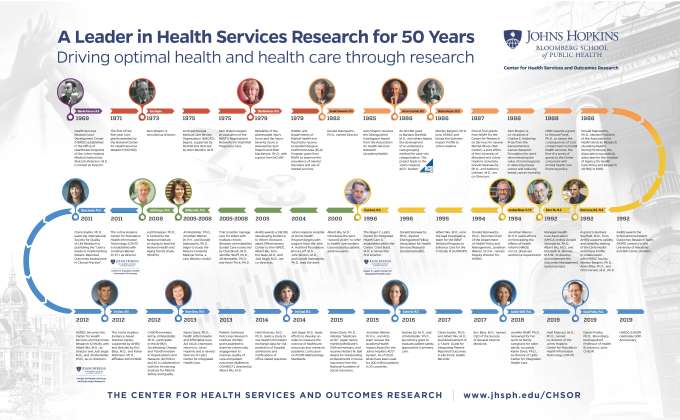History

Learn more about CHSOR's history by clicking the image above.
Established in 1969 as the Health Services Research and Development Center, the Center is one of the oldest in the United States devoted to research on health care. The founding Director was Malcolm Peterson. Sam Shapiro was recruited as Director in 1973. Donald Steinwachs was Director from 1982 until 2011, when Albert Wu assumed that role. Important work conducted at the Center has included:
- Studies of the use, outcomes, and cost of health and mental health services for people with severe mental illnesses such as schizophrenia and major depression. This includes the Epidemiological Catchment Area (ECA) survey, the Center for Research on Services for Severe Mental Illness (SMI Center), and projects like the Schizophrenia Patient Outcomes Research Team (PORT).
- The creation of the ACG System for case-mix categorization by Barbara Starfield, Jonathan Weiner, and Donald Steinwachs. ACGs are now globally recognized and utilized.
- The Roger and Flo Lipitz Center to Advance Policy in Aging and Disability, which developed and evaluated the Guided Care program, a prime example of the Patient-Centered Medical Home.
- Studies in gerontology, including the Hospital at Home Program and the National Health and Aging Trends Study (NHATS).
- Development of patient-reported outcomes assessment tools, such as the Sickness Impact Profile, the MOS-HIV Health Survey, and the Child Health and Illness Profile (CHIP).
- Research on asthma management and outcomes for adults and children, including quality of care studies and the development of the Asthma Therapy Assessment Questionnaire.
- The Developing Evidence to Inform Decisions about Effectiveness (DEcIDE) Center for comparative effectiveness research, which conducted numerous studies on the effectiveness of various treatments.
- The Johns Hopkins Evidence-Based Practice Center, which conducts systematic reviews and meta-analyses on crucial topics in clinical medicine and public health.
- Patient safety research, focusing on handling adverse events, improving patient safety, disclosing adverse events to patients, and supporting health care workers.
Today CHSOR has 25 primary and 28 affiliated faculty from all JHU divisions who continue research in these areas, with an increasing focus on studies of the quality of care, shared decision making, and patient-centered outcomes research. The team also includes 27 research staff and 6 administrative staff members.
